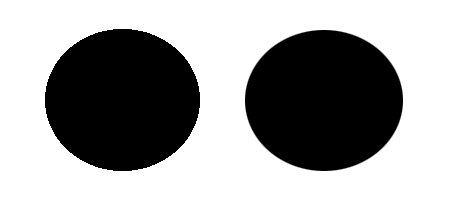If there’s one thing digital photography has no shortage of, it’s confusing vocabulary words. Aliasing, which is a common word in the world of digital everything (video games, CGI, photography), is one of those words that everyone has heard but may not quite understand. And the anti-aliasing feature found on many digital cameras doesn’t do much to explain why you should use it. Not to worry though; anti-aliasing is nowhere near as complicated as it may sound.
The Basics About Pixels
Most digital images are made up of square units known as pixels. If you take any of your digital photographs and zoom in a few times, you’ll notice that the closer you get, the more blocky the image appears. This blocky appearance is the result of the individual pixels becoming more pronounced as the digital image is increased in size.

Aliasing and Anti-aliasing Examples
Your camera’s resolution is directly related to the number of individual pixels it can capture in a given frame, as is often referred to as the mega pixel value. The higher the resolution, the more pixels you get. The more pixels you have, the smoother the lines in your image. For example, think of a staircase where it looks blocky up close but as you move further away it looks more like a diagonal line. This is how pixels work to create shapes in an image.
The Basics About Aliasing
When you look at your image and see the pixels that make up the edges of round or diagonal lines, this is aliasing. When you see pixels drawn rigidly and in only one color, the lines will look more noticeable and jagged. This may not be immediately visible if the pixel is surrounded by others of a similar color, but as the colors increase in contrast, the pixel increases in visibility.
Aliasing is not usually obvious unless an image has been taken at a very low resolution. Most modern digital cameras shoot at resolutions that make aliasing nearly unnoticeable to the naked eye, however it’s easy to spot once these images have been blown up from their original size. Unfortunately, no matter how good the camera is, all digital cameras have some degree of aliasing.
So What is Anti-Aliasing?
Anti-aliasing allows the colors at the edge of pixels to bleed into one another, creating a sort of blurred effect. It may sound counter-intuitive, but blurring the edges of each individual pixel results in sharper images with smoother lines and more natural color differentiation.
As an experiment, try taking one of your digital photographs and dramatically reducing it in size. This will cause the lines of objects in the pictures to look smoother as the size of the picture decreases in size. As the pixels in the image shrink, they become less visible to the naked eye. This is a similar effect to anti-aliasing—slightly blurring each pixel makes it stand out less and blend more smoothly into the image.
Most good digital cameras come with a built in anti-aliasing feature so your pictures won’t have the “blocky” look. Anti-aliasing will make your photographs look more natural and will help to offset any loss of quality caused by a lower resolution camera or setting. It’s always a good idea to shoot at the highest resolution possible, but anti-aliasing helps to make sure your images look great.
Although you may not have realized how important anti-aliasing was before, once you understand the impact on your pictures you won’t want to shoot without it. Jagged lines are one of the major downfalls to digital imagery, and anti-aliasing helps to bridge the gap between ultra-high-resolution cameras and equipment that falls more in the price range of the average hobbyist. If your camera has an anti-aliasing function, make sure to always have it on; your pictures will certainly thank you.
About the Author:
Autumn Lockwood is a writer for Your Picture Frames (www.yourpictureframes.com) and loves taking pictures. Your Picture Frames makes it easy for you to find just the perfect frame for your photo or artwork.
Like This Article?
Don't Miss The Next One!
Join over 100,000 photographers of all experience levels who receive our free photography tips and articles to stay current:






It is not possible to blur the pixels, because they are the smallest unit.
Anti-aliasing averages color values. If I have a pure black diagonal line on a pure white field, then the color of the white pixels, that are adjacent to the black pixels, could be changed from (255,255,255) to (128,128,128). We would then have values, within a row of pixels, similar to “(255,255,255)(255,255,255)(0,0,0)”, become values similar to “(255,255,255)(128,128,128)(0,0,0)”.
Mathematically, pixels are one dimensional points, but we think of them as rectangles, because we are used to seeing graphics programs that draw rectangles when we “zoom in” to the image. It would be just as valid for those programs to always average the values between the one-dimensional points.
Ah, finally… I always wondered what the heck they were talking about…